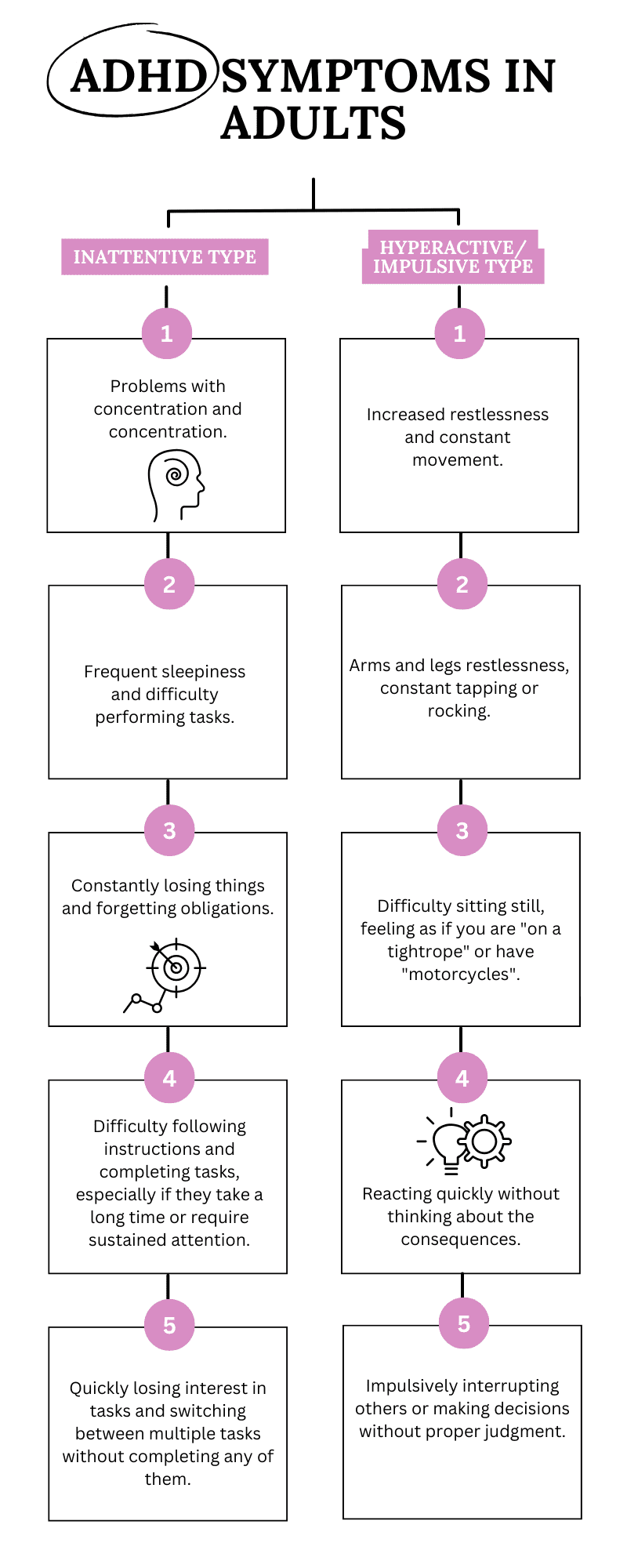10 Important ADHD Symptoms In Adults To Watch Out For
In today’s fast-paced life, we face challenges that require a superior ability to concentrate, organize, and control. However, for some adults, these challenges present a real obstacle in everyday life. Don’t be surprised that ADHD is not just a childhood problem. According to experts, it affects millions of adults worldwide. In this article, we will explore not only the ADHD symptoms in adults but also its origins, which are still a puzzle in the development of the brain and behavior.
Are you interested in how ADHD manifests itself in adulthood and what may lie behind this complex condition? Read on as we delve into the world of ADHD and uncover some hidden facts about this challenging issue in modern psychiatry.
What is ADHD?
Before we move on to the symptoms, I want to briefly explain what ADHD is. ADHD (Attention-Deficit/Hyperactivity Disorder), or attention deficit hyperactivity disorder, is a neurological disorder that affects attention, impulsivity, and hyperactivity. ADHD symptoms are divided into three subtypes: Inattentive type, hyperactive or impulsive type, and combined type. Well, let’s see

Three subtypes of ADHD symptoms in adults
Inattentive type
Attention problems don’t attract much attention, so these signs can be overlooked in both children and adults. People with attention problems have the following symptoms:
- Problems with maintaining attention (they easily focus on interesting and attractive tasks, the opposite is true for demanding and uninteresting tasks)
- Problems in organizing tasks
- Often the person does not follow the direct conversation (easily distracted by unimportant sights, sounds and objects)
- Procrastination of daily tasks
- Disorganization and forgetfulness
- Constantly starting new tasks before the old ones are finished.
- Inability to cope with stress.
- Extreme impatience
- Negligence
- Rapidly losing interest in tasks and switching between multiple tasks without completing any of them.
- Risk in activities, especially safety (Bums, falls, cuts…)
- People with ADHD are more prone to various forms of addiction. Research shows a connection between ADHD and an increased risk of developing addiction to: stimulants, alcohol and others, computer games or the Internet.
Hyperactive/impulsive type
Hyperactivity
Hyperactivity in adults with ADHD manifests as constant restlessness and difficulty sitting still. Individuals may feel as if they have “motorcycles” or as if they are constantly driven by something. This can affect their ability to focus on specific tasks and complete tasks.
- Excitability
- Feeling restless
- Often a person moves faster than others, even when it is not necessary
- The restlessness of hands and feet: The person constantly taps, drums, and plays with objects,…
- Difficulty sitting still
- Queuing problems
Impulsivity
Impulsivity is manifested in quick reactions and a tendency to act without considering the consequences. This affects the ability to control behavior and correctly assess situations.
- Quick reactions such as anger (As many as 70% of adults with ADHD experience mood swings)
- Impulse control problems (impulsively interrupting others or making decisions without thinking)
- Difficulties keeping order
- Efficient performance with time
- Establishing and maintaining mutual relations.
- Difficulty calming down and relaxing
Combined type
It is a combination where the symptoms of both types (attention problems and hyperactivity/impulsivity) come together.
Why the origin of ADHD is a real puzzle
ADHD is a complex neurological disorder, the origin of which is not fully substantiated and researched. Some researchers believe that ADHD results from a combination of genetic, neurological, environmental, and developmental factors.
Genetic factors:
There is a strong genetic component to ADHD. Research indicates that children from families with a history of ADHD are more likely to develop the disorder themselves.
Neurological changes:
ADHD is associated with changes in neural connections and brain chemistry, particularly in the prefrontal cortex (a part of the brain associated with impulse control, attention, and planning) and the limbic system (a part of the brain associated with emotion regulation).
Environmental factors:
Certain environmental factors, such as smoking during pregnancy, environmental lead exposure, premature birth, or early childhood brain damage may be associated with a higher risk of developing ADHD.
Premature brain development:
Developmental factors that affect the formation of the brain during pregnancy and early childhood may influence the development of ADHD.
Food and allergy components:
In some cases, certain food items and allergies may be associated with ADHD symptoms.
The good news is that challenges like attention deficit disorder can be overcome, no matter how difficult they seem. Some studies have examined adults diagnosed with ADHD and found that they are extremely creative, energetic, and innovative. Their hyperactivity and quick thinking can lead to extraordinary achievements in art, technology, science, and, of course, other fields. This suggests that ADHD also brings positive aspects that can be channeled.
How do you think ADHD symptoms affect an individual’s daily life?









